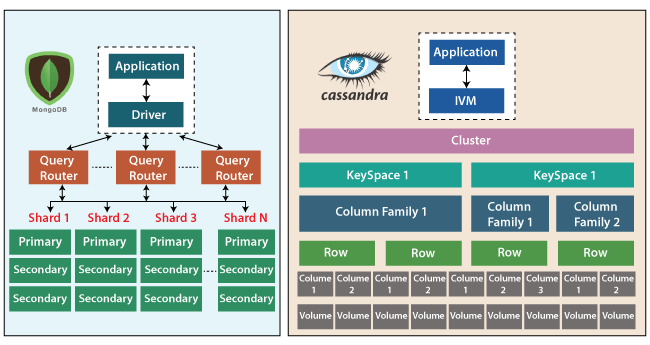Cassandra vs MongoDB
Difference Between Cassandra and MongoDB
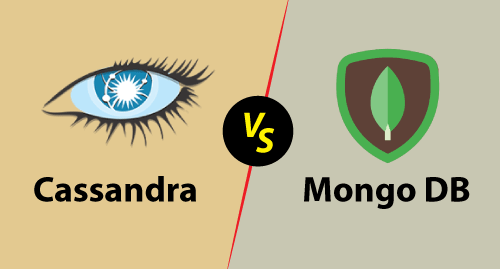
Productivity, layout, and operational factors are the most important factors to consider when comparing Cassandra versus MongoDB. While the approaches to data storage and manipulation in both systems entice consumers, the actual procedures are sufficiently dissimilar to split their user populations as per priorities.
Cassandra:
Cassandra is a distributed NoSQL database management system developed by Apache.Mostly deals with high amount of data stored across various machines. The large scale data is handled with the help of the architecture.
Same data is stored across various machines i.e, replica of data which enables high availability and no single point failure.
MongoDB:
MongoDB is a popular open-source database that comes under the NoSQL database family and is used for storing large amounts of data.MongoDB is built with auto shardingfor high availability and scalability.MongoDB employs JSON to store data in the form of documents that can vary in structure, resulting in a dynamic, flexible schema.
It is designed to meet the needs of modern apps by providing a technological foundation that allows one to demonstrate the best way to work with data and place data where you want it in an intelligent way.
Similarities:
- MongoDB and Cassandra are both NoSQL databases with open source distributions.
- These two database types do not meet the concepts of consistency and normalization which in-deed is present in the RDBMS.
- The databases Cassandra and MongoDB are not ACID compliant i.e, Atomicity, Consistency, Isolation, Durability features.
- None of the Cassandra or MongoDB databases can be used in place of standard RDBMS databases.
Differences:
- Data Model:
Cassandra is a much more traditional model which has a table structure with rows and columns. While on the other hand MongoDB's data model is object oriented or otherwise data oriented.
Data in MongoDB can have properties and can be nested on multiple levels. On the other hand data in the Cassandra data model is more structured, with each column having a unique type.
- Master Node:
Cassandra has multiple nodes in a data center out of which one node processes the data while other store replica. This ensures durability and no single point failure. MongoDB has a disadvantage in this case as it has mater-slave node format. Where one master node monitor and control the slave nodes. If the master node fails there will be a lag in performance. In that lag time no more input can be passed.
- Secondary Indexes:
MongoDB beats Cassandra in applications that demand secondary indexes and flexibility in data model.Cassandra supports only cursors for secondary indexes, but only for single columns and equality comparisons.
As a consequence, MongoDB makes indexing any property of the data contained in the database a lot easier.This property facilitates querying.
- Scalability:
There are numerous master nodes in Cassandra. These master nodes take request from coordinator node and make a replica respectively of data and store it. As a result, the larger a cluster's master nodes are, the better it will scale. There is only one master node in MongoDB. Only the input is accepted by this master node. Aside from that, each node serves as an output. As a result, if data needs to be written in slave nodes, it must first go through the master node.
When comparing the two, Cassandra outperforms MongoDB in terms of scalability.
- Query Language:
Cassandra includes a user-friendly set of queries known as CQL (Cassandra Query Language) that developers with existing understanding of SQL may simply adapt. On the other handMongoDB currently does not have a query language. MongoDB queries are organised as JSON fragments.
- Aggregation:
The Aggregation framework in MongoDB is built-in. There is no built-in aggregating framework in Cassandra. External tools such as Apache Spark, Hadoop, and others are used by Cassandra. While in the case of MongoDBSmall and medium data traffic are supported by this architecture. In addition, as the complexity of the framework grows, it becomes more difficult to debug.
- Schema:
A user in MongoDB has the power to change the database's enforcement of any schema. On the other hand, static typing is provided by Cassandra. The kind of column must be defined by the user at the start.
In MongoDB each database may have a unique structure depending on the interpret data of an application or user’s requirements.
- Performance:
As Cassandra can handle numerous master nodes in a cluster, it is considered to perform better in applications that demand a lot of data. MongoDB, on the other hand, will not be suitable for applications with high data loads because it cannot scale with the performance due to master-slave architecture.
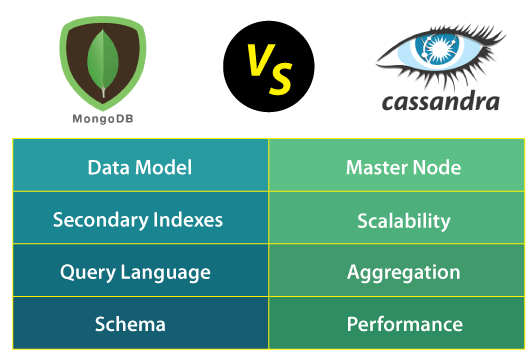
Architecture’s:
Cassandra Architecture:
Dynamo:
It has a ring-type structure. There is no master node and all nodes are connected to one another. If the request is given it hits one of the nodes and that node processes the request and writes on to the database.
- Gossip: The node after writing signals other nodes to update the data as well. This way of interaction between nodes is known as Gossip.
- Failure Detection: Due to absence of central node, failure of the node to update is usual which is detected and recovered.
- Replication: As the requirement the replication of data can be done in the nodes.
Storage Engine:
- Commit-Log: Any data in Cassandra is written before in commit-log then in mem-tables. This improves the durability of data and risk of shutdown.
- Mem-tables: These are memory structures where Cassandra buffer writes the data.
- SSTables: Themem-tablesare further flushed into the disk and converted into SStables. These are immutable data files used for prevention of risk.
Cassandra’s core objective to accomplish large scalability, availability, and having storage requirements accordingly is achieved through the architecture of Cassandra.
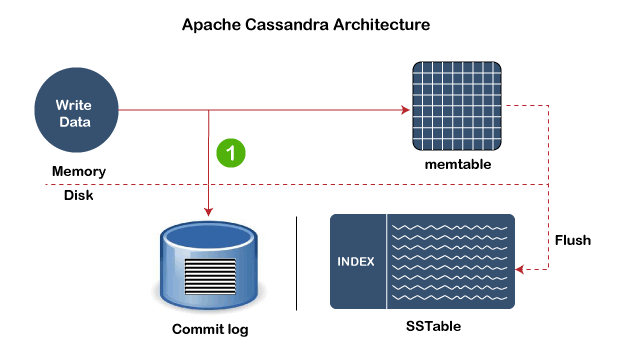
MongoDB Architecture:
- _id: Every MongoDB document must have this field. The _id field in a MongoDB document represents a unique value. The _id field functions similarly to the document's primary key. MongoDB will create a _id field for you if you create a new document without one.
- Collection: A collection of MongoDB documents is referred to as a "collection”. A collection is the same as a table in any other relational database management system (RDMS), such as Oracle or MySQL. A database's collection is a subset of it. Collections, as stated in the introduction, do not impose any kind of structure.
- Cursor – A cursor gives reference to the set of results returned by a query. It is also a pointer. To retrieve results, clients can loop through a cursor.
- Database – Each database has its own collection of files on the file system. Multiple databases can be stored on a MongoDB server.A database is a container for collections, similar to how a relational database management system (RDMS) is a container for tables.
- Field: A name-value pair in a document is called a field. In relational databases, fields are similar to columns.There are zero or more fields in a document.
- JSON:JavaScript Object Notation. This is a text file which gives a format structures and details of a file. It is human readable. JSON is supported in a wide range of programming languages.
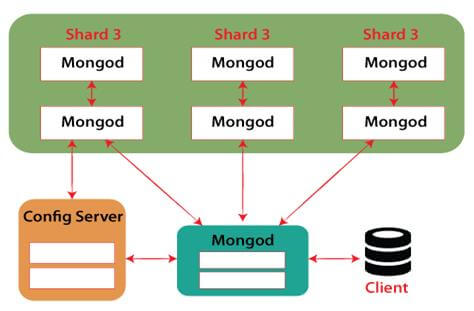
Architectural Differences:
Data is saved in Cassandra's non-relational partitions in the same way it is in any other NoSQL platform. MongoDB is a document-based database that extends the NoSQL idea. This implies that whenever you put data into a MongoDB instance, a (JSON-type) document containing the values and metadata is created.
